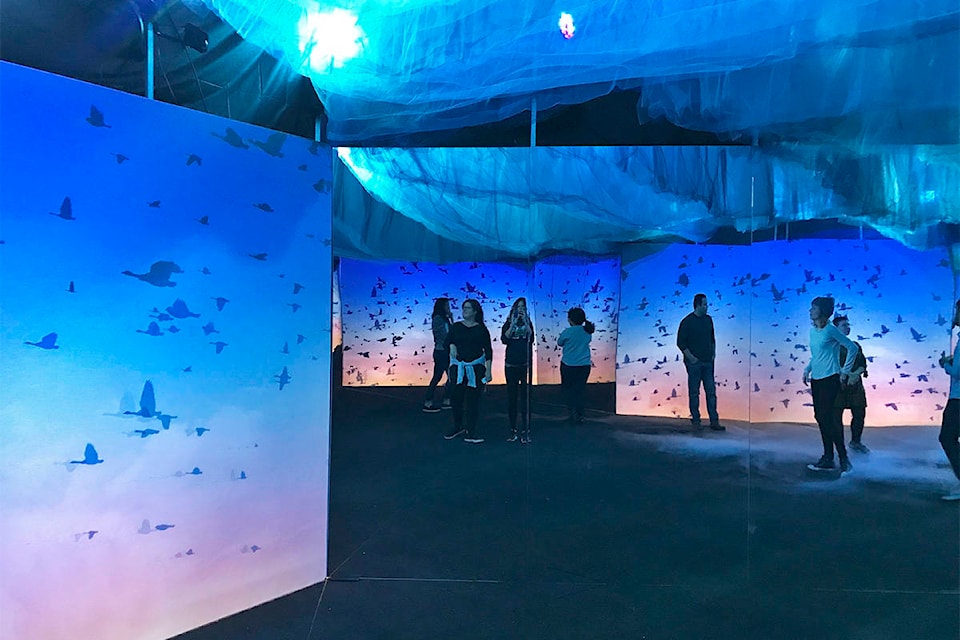The Arctic National Wildlife Refuge is perched on the top of the continent out of reach to most, save for a select few.
Sheer geography, then, presents disconnect at a crucial time when the largest refuge left in the U.S. is in the crosshairs of oil and gas development.
In a bid to raise awareness about what’s been playing out there, a simulated version was delivered to residents of three major U.S. cities instead.
The interactive exhibit, or “experience,” harnessed wall-to-wall cinematography and found footage of the refuge. Sights were paired with smells and tundra-like ground in order to bring about a tactile feel. The idea was to transport participants who may never make it there.
The Wilderness Society was the principle architect of four-day events in New York City, Washington DC and San Francisco, the final locale to host. The run of exhibits, primarily geared towards young people, culminated on Nov. 24.
“It is not easy for folks to get up to the refuge,” said Edit Ruano, director of regional communications for the organization. “Folks can’t even place where the Arctic refuge is. They often had told us they didn’t know it was even in the U.S. and in Alaska. This was about bringing the refuge to them.”
The exhibit was broken up into several rooms, the first of which simulated the aurora borealis. Bernadette Demientieff, executive director of the Gwich’in Steering Committee, was there to walk people through the area in order to orient them.
“It’s kind of a 360 film experience, with sights and smells that lets people see the Arctic refuge completely,” Ruano said. “It’s basically taking them through seasons of the refuge.”
There’s a bleak turning point when the threat is introduced.
Videos show legislators — Senator Lisa Murkowski, for instance — working to open up the refuge to oil and gas drilling.
In September, the U.S. government decided on the most aggressive extraction program for a piece of the refuge via its final environmental impact statement. It calls for providing total access to oil and gas companies, with a few surface occupancy exceptions.
U.S. legislation under the tax act stipulates that one lease must be issued in four years and that no fewer than two lease sales, each to include at least 400,000 acres with the highest potential of hydrocarbons, must occur by 2024.
According to a recent story by Reuters, the Trump administration won’t secure its first lease sale in time. The article cites delays in the environmental review process.
The exhibit doesn’t end on a doom and gloom note, though. It pivots to images and video of the people who have been fighting to protect the refuge for decades, who continue to lead the charge — the Gwich’in.
“Their voices come up and are really providing a call to action to those who walk through the experience and asking them to really join them,” Ruano said.
There are five phones on a wall, each linked to voicemails belonging to oil CEOs or Interior Secretary David Bernhardt. Thousands of people left voice messages, calling on them to pull away from the refuge.
“We didn’t think people would be excited to leave voicemails because young people tend to text,” Ruano said.
In New York, 1,100 voice mails were left.
“We saw young people literally going down the row and leaving a voice mail for every single person,” she said. “It was pretty amazing. It blew my mind.”
There’s a manifesto that people signed, too. It garnered more than 10,000 signatures.
“That’s really the goal,” Ruano said, “that this is the entry point, their moment of connection to the Arctic refuge, and then, in the long-term, continue engaging all of these young activists and direct action into protecting the refuge.
“Our hope is that these 10,000 people that have walked through the experience share it with five friends. These are young people who care about social justice, who care about human rights, who care about climate change. The Arctic refuge is a place where all of those concerns meet, and it’s one of the places that’s most in danger. Our hope is that they stay engaged, stay active, want to learn more, share and help grow the community.”
Contact Julien Gignac at julien.gignac@yukon-news.com
